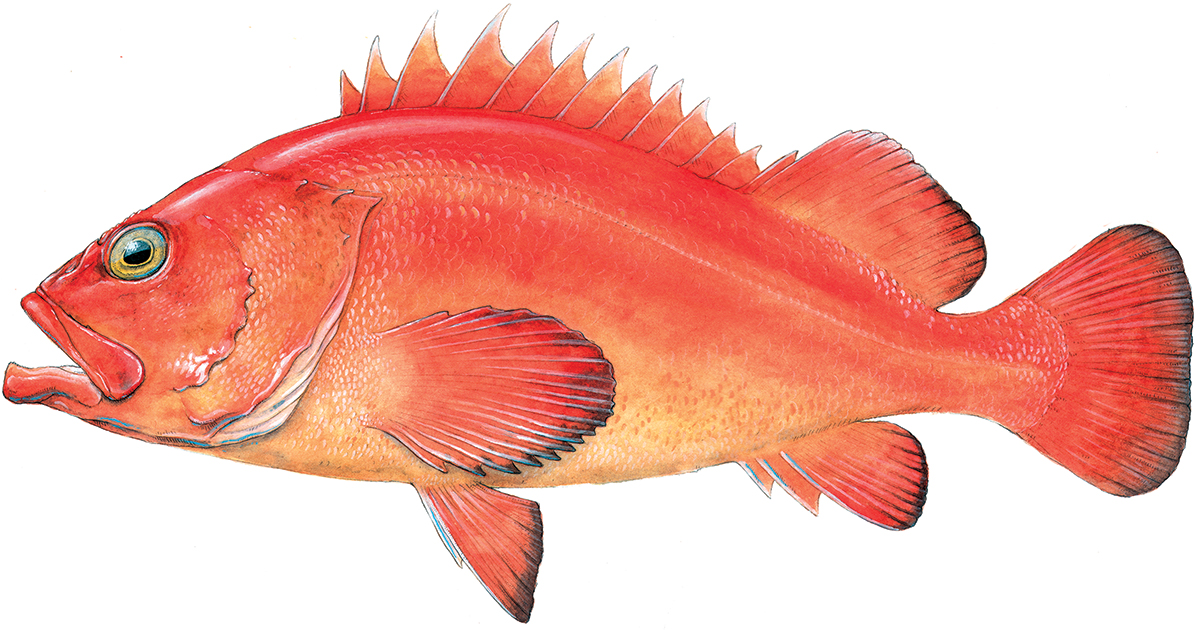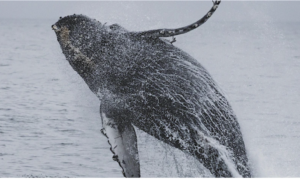Galapagos giant tortoises, African elephants, and bowhead whales share something: very long lives. Perhaps their life spans contribute to public perception of these species as wise and noble. To that group you might add the extraordinarily long-lived yelloweye rockfish, which can reach up to 118 years in age.
Yelloweye rockfish are a large eastern Pacific species with a distinct look: up to 3.5 feet in length, bright orange-red hue, and most notably, the yellow eyes for which they are named. Juveniles—fish under the age of 15 or so—have a darker orange-red body, accentuated by two white stripes. Yelloweye rockfish, upon reaching maturity, reside on the ocean floor. Here they live a sheltered, mostly solitary life, hardly ever leaving their rock pile, dining on zooplankton, small crustaceans, and other fish. “Yelloweye are one of the larger rockfishes, and they have huge mouths and large bellies, so they have a large predation capacity,” NOAA fisheries biologist Jason Cope says by email.
Occasionally they bite into baited fishhooks. For a long-lived, slow-maturing species that was declared overfished in 2002, even accidental catch might hamper recovery. Although a female yelloweye rockfish can produce up to 2.7 million eggs, the vast majority of larval rockfish do not survive to maturity. Shortly after fishery restrictions went into place, Cope says, there was a good yelloweye rockfish “recruitment” year—meaning that a large number of the babies survived. But that still means 15 to 20 years waiting for that baby boom to mature and trying, in the meantime, to keep them off of fishermen’s hooks.
“This recruitment is like putting money back in a bank that had previously had very high withdrawal levels,” Cope says. “The difficult thing about rebuilding many rockfishes is that it can take time. We are hopeful that the signs in the data that indicate a good recruitment a decade ago will bring about optimistic population growth and recover the yelloweye rockfish population coastwide.”
Yelloweye rockfish, like most other rockfish species, are particularly susceptible to barotrauma when pulled up from the depths. Barotrauma is caused by changes in air or water pressure, and nearly anyone who has been on an airplane has experienced a mild version of this condition, which is easily remedied by making your ears “pop”. Yelloweye rockfish can’t pop their ears, or otherwise equalize pressure. When they are brought up by anglers from the deep, air in their swim bladder expands, so anglers at the surface are greeted by a grotesque version of the fish, with bulging eyes and the stomach of the fish jutting out from its mouth. If the angler simply throws the fish back in the water, it will float on the surface, leaving itself vulnerable to predators. CDFW asks fishermen to put the fish back using a descending device, which NOAA studies suggest could mean as much as 85 percent survival in California rockfish.
Serena Ingalls is a junior at Albany High School and a Bay Nature editorial intern through the EDSET program.





